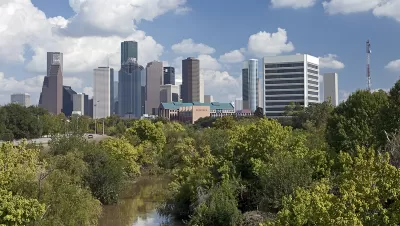The executive director of the Bayou Land Conservancy takes to the pages of the Houston Chronicle to describe the conservationist and landscape-focused efforts that can prevent floods like those that struck Houston this week.

"For the past twenty years, we at Bayou Land Conservancy have watched, horrified, as the Houston region's wetlands are scraped and filled in — directly resulting in increased flooding," begins an editorial by Jennifer Lorenz.
The reason for the account is the catastrophic flooding in Houston this week. According to the article, wetlands serve as the kidneys of the area's watersheds, running a process that serves as the foundation of the region's ecology.
Lorenz adds:
The rampant destruction of our forested and prairie wetlands is upsetting this balance, drastically reducing the land's ability to absorb water. By allowing so many wetlands to be turned into subdivisions, we're not just kicking them to the curb; we're turning them into curbs. We need the ecological equivalent of dialysis.
The editorial also includes a list of suggested actions to balance the need to protect the watershed while also meeting the construction demands of a growing population. The list includes, with more details in the article, planting more trees and native plants, better enforcement of existing construction regulations, more citizen-power in the building permit process, better landscaping on residential properties, better watershed awareness, and ceasing and desisting " trapezoidal concrete detention areas." On that last issue, Florenz writes: "Engineers like right angles; nature doesn't."
FULL STORY: Wrecked wetlands lead to flooding. Here's what you can do.

Study: Maui’s Plan to Convert Vacation Rentals to Long-Term Housing Could Cause Nearly $1 Billion Economic Loss
The plan would reduce visitor accommodation by 25,% resulting in 1,900 jobs lost.

North Texas Transit Leaders Tout Benefits of TOD for Growing Region
At a summit focused on transit-oriented development, policymakers discussed how North Texas’ expanded light rail system can serve as a tool for economic growth.

Using Old Oil and Gas Wells for Green Energy Storage
Penn State researchers have found that repurposing abandoned oil and gas wells for geothermal-assisted compressed-air energy storage can boost efficiency, reduce environmental risks, and support clean energy and job transitions.

Private Donations Propel Early Restoration of Palisades Playground
Los Angeles has secured over $1.3 million in private funding to restore the Pacific Palisades playground months ahead of schedule, creating a modern, accessible space that supports community healing after recent wildfires.

From Blight to Benefit: Early Results From California’s Equitable Cleanup Program
The Equitable Community Revitalization Grant (ECRG) program is reshaping brownfield redevelopment by prioritizing projects in low-income and environmental justice communities, emphasizing equity, transparency, and community benefits.

Planting Relief: Tackling Las Vegas Heat One Tree at a Time
Nevada Plants, a Las Vegas-based nonprofit, is combating the city’s extreme urban heat by giving away trees to residents in underserved neighborhoods, promoting shade, sustainability, and community health.
Urban Design for Planners 1: Software Tools
This six-course series explores essential urban design concepts using open source software and equips planners with the tools they need to participate fully in the urban design process.
Planning for Universal Design
Learn the tools for implementing Universal Design in planning regulations.
Ascent Environmental
Borough of Carlisle
Institute for Housing and Urban Development Studies (IHS)
City of Grandview
Harvard GSD Executive Education
Toledo-Lucas County Plan Commissions
Salt Lake City
NYU Wagner Graduate School of Public Service





























